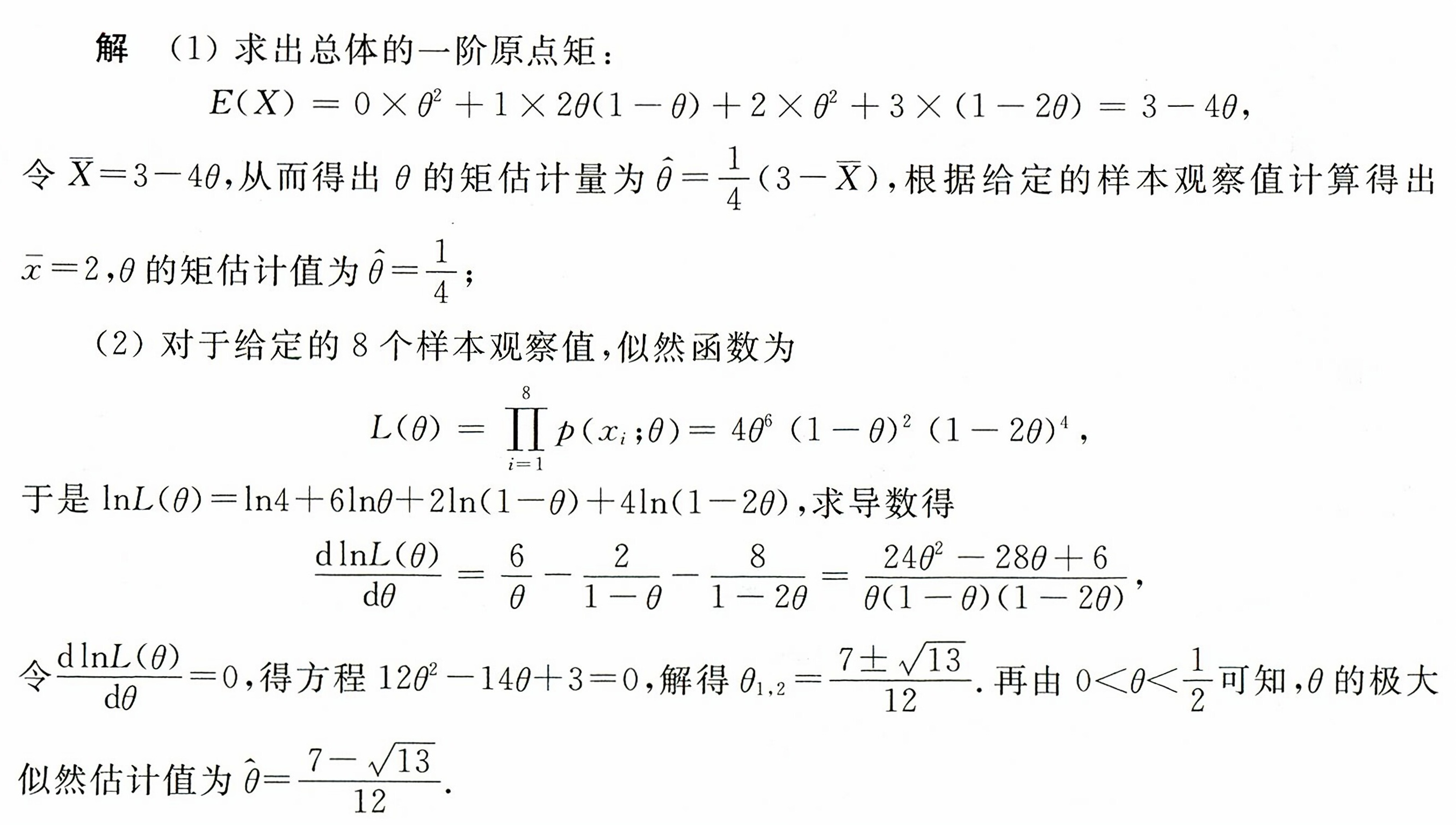题目
设总体X的概率分布为-|||-X 0 1 2 3-|||-P θ^2 .(1-0) . θ^2 .https:/img.zuoyebang.cc/zyb_cc1d55810cc7d52776d9633cf4097f0a.jpg-20-|||-其中 theta (0lt theta lt dfrac (1)(2)) 是未知参数,利用总体X的如下样本值3,1,3,0,3,1,2,3.试求:(1)θ的-|||-矩估计值;(2)θ的极大似然估计值.

题目解答
答案

解析
步骤 1:求总体的一阶原点矩
根据给定的概率分布,总体X的一阶原点矩(即期望值)为:
$E(X) = 0 \cdot \theta^2 + 1 \cdot 2\theta(1-\theta) + 2 \cdot \theta^2 + 3 \cdot (1-2\theta)$
化简得:
$E(X) = 3 - 4\theta$
步骤 2:求θ的矩估计量
令样本均值 $\overline{X}$ 等于总体的一阶原点矩,即:
$\overline{X} = 3 - 4\theta$
解得θ的矩估计量为:
$\hat{\theta} = \dfrac{1}{4}(3 - \overline{X})$
步骤 3:计算θ的矩估计值
根据给定的样本观察值3,1,3,0,3,1,2,3,计算样本均值 $\overline{x}$ 为:
$\overline{x} = \dfrac{3+1+3+0+3+1+2+3}{8} = 2$
代入矩估计量公式,得θ的矩估计值为:
$\hat{\theta} = \dfrac{1}{4}(3 - 2) = \dfrac{1}{4}$
步骤 4:求θ的极大似然估计值
对于给定的8个样本观察值,似然函数为:
$L(\theta) = \theta^2 \cdot (2\theta(1-\theta))^2 \cdot \theta^2 \cdot (1-2\theta)^4$
化简得:
$L(\theta) = 4\theta^6(1-\theta)^2(1-2\theta)^4$
对似然函数取对数,得:
$\ln L(\theta) = \ln 4 + 6\ln\theta - 2\ln(1-\theta) + 4\ln(1-2\theta)$
对 $\ln L(\theta)$ 求导,得:
$\dfrac{d\ln L(\theta)}{d\theta} = \dfrac{6}{\theta} - \dfrac{2}{1-\theta} - \dfrac{8}{1-2\theta}$
令导数等于0,得方程:
$12\theta^2 - 14\theta + 3 = 0$
解得:
$\theta_{1,2} = \dfrac{7 \pm \sqrt{13}}{12}$
由 $0 < \theta < \dfrac{1}{2}$ 可知,θ的极大似然估计值为:
$\hat{\theta} = \dfrac{7 - \sqrt{13}}{12}$
根据给定的概率分布,总体X的一阶原点矩(即期望值)为:
$E(X) = 0 \cdot \theta^2 + 1 \cdot 2\theta(1-\theta) + 2 \cdot \theta^2 + 3 \cdot (1-2\theta)$
化简得:
$E(X) = 3 - 4\theta$
步骤 2:求θ的矩估计量
令样本均值 $\overline{X}$ 等于总体的一阶原点矩,即:
$\overline{X} = 3 - 4\theta$
解得θ的矩估计量为:
$\hat{\theta} = \dfrac{1}{4}(3 - \overline{X})$
步骤 3:计算θ的矩估计值
根据给定的样本观察值3,1,3,0,3,1,2,3,计算样本均值 $\overline{x}$ 为:
$\overline{x} = \dfrac{3+1+3+0+3+1+2+3}{8} = 2$
代入矩估计量公式,得θ的矩估计值为:
$\hat{\theta} = \dfrac{1}{4}(3 - 2) = \dfrac{1}{4}$
步骤 4:求θ的极大似然估计值
对于给定的8个样本观察值,似然函数为:
$L(\theta) = \theta^2 \cdot (2\theta(1-\theta))^2 \cdot \theta^2 \cdot (1-2\theta)^4$
化简得:
$L(\theta) = 4\theta^6(1-\theta)^2(1-2\theta)^4$
对似然函数取对数,得:
$\ln L(\theta) = \ln 4 + 6\ln\theta - 2\ln(1-\theta) + 4\ln(1-2\theta)$
对 $\ln L(\theta)$ 求导,得:
$\dfrac{d\ln L(\theta)}{d\theta} = \dfrac{6}{\theta} - \dfrac{2}{1-\theta} - \dfrac{8}{1-2\theta}$
令导数等于0,得方程:
$12\theta^2 - 14\theta + 3 = 0$
解得:
$\theta_{1,2} = \dfrac{7 \pm \sqrt{13}}{12}$
由 $0 < \theta < \dfrac{1}{2}$ 可知,θ的极大似然估计值为:
$\hat{\theta} = \dfrac{7 - \sqrt{13}}{12}$